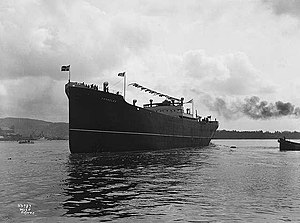 Fernglen shortly after launch in 1929
| |
| History | |
|---|---|
| Name |
|
| Namesake | |
| Owner |
|
| Operator | Mittelmeer Reederei GmbH (1942–1943) |
| Port of registry |
|
| Route | Fern Line (1929–1934) |
| Builder | Akers Mekaniske Verksted, Oslo, Norway |
| Yard number | 434 |
| Launched | 15 May 1929 |
| Completed | July 1929 |
| Identification |
|
| Fate | Sunk by air attack 19 October 1943 |
| General characteristics | |
| Tonnage | |
| Length | 117.4 m (385 ft) |
| Beam | 16.7 m (55 ft) |
| Depth | 7 metres (23 ft) |
| Decks | 2 |
| Installed power | 624 nominal horsepower |
| Propulsion | 2 6-cylinder 4S.C.SA diesel engines, twin screw propellers |
| Speed | 12.5 knots (23.2 km/h) |
Sinfra was a cargo ship built in 1929 as Fernglen by Akers Mekaniske Verksted in Oslo, Norway, for a Norwegian shipping company. The ship was sold to Swedish owners in 1934 and to a French company in 1939, on the last occasion having her name changed to Sinfra.
Sinfra was confiscated by German authorities in 1942, and used by them in the Mediterranean. On 19 October 1943, Sinfra was bombed and sunk by Allied aircraft north of Souda Bay, Crete. Around 2,000 people were killed in the sinking, the majority being Italian POWs.
